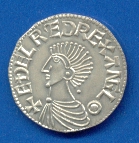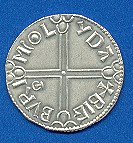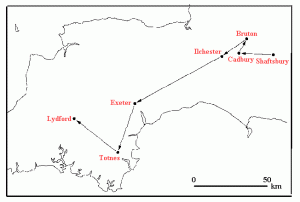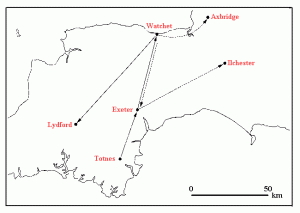The mint at Lydford produced over 1.5 million silver pennies from 973 to 1066. However, initially, every six years and later every three years, all existing silver pennies were recalled by the Crown Authority, and pennies of identical size and weight but of changed design were minted from the same silver. So pennies were re-created many times adding to this number.
The mint operated continuously from the reigns of Ethelred II (AD 976-1016), Cnut, Harold and Edward the Confessor (AD 1042-1066). However no coins were produced there after the Norman invasion in 1066.
There are twenty-one Lydford Silver Pennies in the British Museum and several in the Royal Albert Memorial Museum in Exeter, but museums in Scandinavia, especially in Stockholm, contain several hundred Lydford Pennies, mostly, no doubt, the result of the “Dangeld” payment extorted from the Anglo-Saxons by the Vikings more than one thousand years ago.
The pennies of Etheldred II found in Stockholm have several variations of the name ‘Lydford’ : Lyda, Lydan, Lydanf, Lydafor, Lydanfoi, Lydefo, Lydafon. The mint-masters names were Goda, Bruna, Godric, Godwine, Elfstan, Ethered, Etheryd, Ethelstan. The pennies found in Stockholm have: Aelfwine on Lyda, Bruna on Lyda, Godric on Lyda, Saewine onn Lydef, Saewine o Lyd, Seawine o Lhyd, Saewine on Lhyda, Saewine on lllydaf. Of Harold I, only two are known Aelfric on Lydaf, Aelfwine on Lyda and, of Edward the confessor, one Alefric on Lydafo
Each coin was made of solid silver, equivalent to stirling silver, and had a diameter of about 20 mm and a weight close to 1.6 grams.
  |
This Lydford Penny, minted between 978 and 1016 AD, shows the head of Aethelred II, who was the Anglo-Saxon King of Wessex in that period. The long-cross allowed the coin to be cut into quarters (that being necessary since a silver penny was approximately the payment for one day’s work). |
The precise location of the mint is unknown. There is still a street called Silver street in Lydford. However, it is outside of the towns Saxon defences. The coins of the Anglo-Saxons were made at a variety of local mints by expert metal workers called “Moneyers”. Every new Anglo-Saxon silver penny carried the life-long signature mark of the Moneyer (the Mint-Master) who had minted the coin and because the dates of the successive styles of the pennies are well known, it has been found possible to track the careers of the Moneyers as they moved from one Mint to another.
In his article of 2002 entitled “The Anglo-Saxon Mint at Lydford” (published in Rep. Trans. Devon Ass. Advmt Sci. 134 pages 9-32, December 2002), John Allan presented maps of the likely routes in Devon of two such Moneyers, Hunwine and Aelfwine. The article cites Stewart (1970) and Blackburn (1974) as the sources of the information. The maps from John Allan’s article are shown below.
 Likely Career Route of the Moneyer Aelfwine Likely Career Route of the Moneyer Aelfwineduring the years circa AD 1003 to 1042 (J Allan, Rep. Trans. Devon Ass. Advmt Sci. 134 (2002) 9-32). |
 Likely Career Route of the Moneyer Hunwine during the years AD 983-5 to 1025 (J Allan, Rep. Trans. Devon Ass. Advmt Sci. 134 (2002) 9-32). Likely Career Route of the Moneyer Hunwine during the years AD 983-5 to 1025 (J Allan, Rep. Trans. Devon Ass. Advmt Sci. 134 (2002) 9-32). |